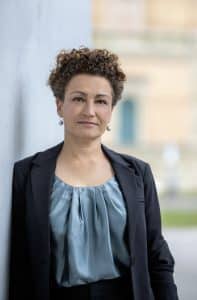
2023 PLENARY ADDRESS

Photo credit: Martina Bogdahn
Wednesday, November 15
7:00 – 8:30pm CST | Hilton Chicago*
*The Plenary Address will be available to virtual attendees on Zoom and recorded.
The 2023 Plenary Address will be given by Rubina Raja (Aarhus University, Denmark and director of the Danish National Research Foundation’s Centre of Excellence for Urban Network Evolutions).
Rubina Raja is professor of classical art and archaeology at Aarhus University, Denmark and director of the Danish National Research Foundation’s Centre of Excellence for Urban Network Evolutions. She heads several research projects focusing on the archaeology and history of Palmyra, including the Palmyra Portrait Project. Raja is an experienced field archaeologist having headed several large-scale excavation projects in Italy and the Middle East. Raja’s research focuses on societal and urban developments as well as networks from the Hellenistic to the medieval periods, architecture, iconography, and religious life in Antiquity and Late Antiquity. While being a classical archaeologist, she has pioneered work in the fields intersecting archaeology and natural sciences bringing high-definition studies of the past to the forefront in its historical contexts. She has published widely the Late Hellenistic to early Medieval periods, with a focus on the eastern Mediterranean, and her monographs include Pearl of the Desert. A history of Palmyra (OUP, 2022) and Urban Development and Regional Identity in the Eastern Roman Provinces, 50 BC – AD 250: Aphrodisias, Athens, Ephesos, Gerasa (Museum Tusculanum, 2012) and The Ingholt Archive (co-authored with Olympia Bobou, Amy Miranda and Jean-Baptiste Yon, Brepols, 2022).
Death by Data? Or What Has a Decade of Research on Palmyrene Funerary Sculpture Taught Us about the Ancient World?
Palmyra, ancient Tadmor, the famous oasis city in the Syrian Desert, flourished in the first three centuries CE. The city’s archaeology and history have fascinated scholars and laypeople alike since the seventeenth century, when the first Western explorers visited the site. Since the war in Syria broke out, the site has gained further attention, not least due to the extensive damage and looting that has taken place. The archaeological evidence from the city is vast and complex, and particularly the city’s abundant funerary art has held a central place in scholarship since the late nineteenth century. This lecture will explore Palmyra’s archaeology and history through its art, architecture, and written culture and will ask the pivotal question: in which ways does the abundant material and written evidence–much of which has recently been collected in a set of new corpus works on the city’s funerary portraiture, monuments, and inscriptions–add to our knowledge of Palmyra’s urban culture, as well as to a more profound understanding of urban cultures in the Roman East in general?